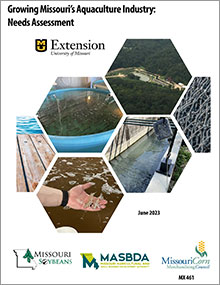Editor’s note
The following abstract describes a publication that is only available as a downloadable PDF.
Summary

Missouri’s aquaculture industry contains many small but diverse businesses, based on responses from 20 active businesses that participated in a 2023 aquaculture needs assessment survey. Those businesses represented 17 counties, and the survey had an estimated 70% response rate. The average respondent was a small business with seven employees that had been in business for 39 years. Respondents said they primarily use ponds or flow-through raceways and produce nearly eight different aquaculture species on average. In total, respondents produced 46 different species in 2022. Bluegill and largemouth bass were the two most common. They each contributed between 21% and 25% of total business sales.
Producers expressed concern about earning sustainable profit. Many strongly agreed that input costs were rising faster than prices they charge buyers. Most felt business diversification would not improve profit. Producers shared unified perspectives on the outlook of Missouri aquaculture industry. Most agreed that the industry needs to be innovative at cutting costs to operate competitively. They also thought the industry’s future depends on creating direct-to-consumer distribution channels. Despite the concern about profitability and rising costs within their own businesses, 78% of respondents felt aquaculture producers have growing market opportunities.
Missouri aquaculture producers sell a variety of species into different markets. Four in five said they sell fish for pond stocking, and 43% noted selling fish to food markets. On average, operations focused on pond stocking were less diverse. They produced six species, but operations that stock ponds and sell to food markets said they produce up to 11 species. Approximately half of respondents sold products (e.g., fish for pond stocking, fish for food markets) through a single channel. The most common market channel was direct-to-consumer sales followed by sales to other aquaculture producers. Half of respondents had no desire to change market channels. Producers were interested in expanding sales of processed fish, selling to restaurants and pursuing direct-to-consumer markets. The largest perceived barriers to exploring new market channels were capital and advertising and transportation costs.
Comparing their businesses in 2022 and 2021, most producers sold similar aquaculture products and quantities. Half increased their total sales, but most indicated their net income stayed the same. Labor, feed and energy costs accounted for an estimated two-thirds of total business expenses. Most businesses had the same number of employees, but 30% had increased hours of hired labor. Feed costs averaged 22% of total business expenses in 2022. Missouri producers purchased feed from a range of companies, and half used more than one feed supplier — likely to meet the dietary needs of diverse aquaculture species.
Contents
- Summary
- Methodology
- Business Context and Industry Background
- Business Age and Size
- Production Systems and Products
- 2022 Operating Expenses
- Aquaculture Feed Sources and Needs
- Market Practices of Missouri Aquaculture Producers
- Customer Types and Business Diversification
- Market Channels and Barriers
- Changes Among Missouri Aquaculture Businesses from 2021 to 2022
- Future of Aquaculture Businesses and the Industry
- Desired Changes to your Business
- Perceptions of the Overall State of your Aquaculture Business
- Perceptions of Missouri’s Aquaculture Industry
- Final Comments by Responding Aquaculture Businesses
- Appendix: Missouri Aquaculture Survey Instrument
Pages
- 38